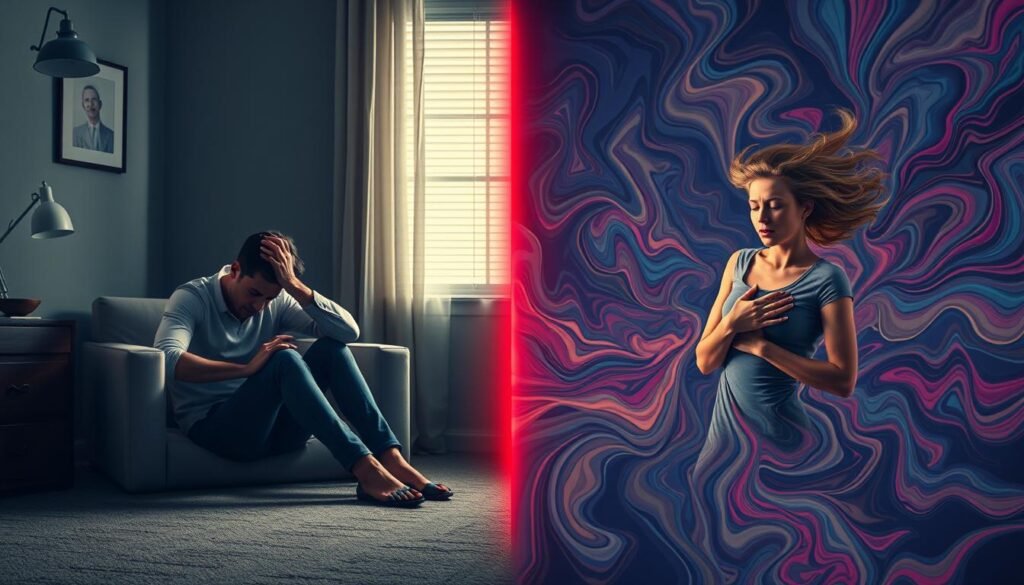Did you know depression affects about half of Parkinson’s disease patients? This fact points out the connection between mood issues and brain conditions. Strattera, a non-stimulant antidepressant, is gaining attention as a treatment. It’s especially useful for those with ADHD too. Knowing about Strattera can help patients and doctors make better treatment choices.
Strattera treats ADHD by working on the brain’s norepinephrine. But, it might help with depression too. Its use is becoming more popular. This guide talks about how Strattera works for depression. It covers its effectiveness and safety. This is valuable information for those wanting to learn about Strattera.
Key Takeaways
- Strattera may serve as an alternative for patients with depression, especially those who are resistant to traditional antidepressants.
- It is particularly beneficial for individuals with comorbid ADHD and depressive symptoms.
- Unlike other antidepressants, Strattera does not carry the stimulant properties commonly associated with ADHD medications.
- Clinical evidence is mixed, highlighting the need for personalized treatment plans.
- Consultation with a healthcare professional is crucial before starting or combining Strattera with other treatments.
- Strattera has shown promise by targeting symptoms like fatigue and poor concentration, common in depressive disorders.
Understanding Strattera
Strattera is a brand name for atomoxetine, a medication for ADHD. It was the first non-stimulant ADHD treatment approved by the FDA in 2002. It helps people who don’t do well with traditional stimulants like Adderall.
What is Strattera?
Strattera is a selective norepinephrine reuptake inhibitor (SNRI). It changes norepinephrine levels in the brain to improve focus and lessen impulsivity. It’s a non-controlled substance, so there’s less chance of becoming dependent on it.
How Does Strattera Work?
Strattera boosts norepinephrine to stabilize mood and improve attention. It can ease ADHD symptoms and help with depression too. You need to use it for three to four weeks to see full benefits.
It’s especially useful for those who can’t take stimulants due to side effects.
Strattera for Depression: Overview
People are looking into Strattera for treating major depressive disorder. Known mainly for ADHD, it’s promising for depression too. Strattera targets norepinephrine, which might help improve mood.
Potential Benefits of Strattera as an Antidepressant
Strattera has some key benefits for handling depression. Studies show it could aid those with ADHD in managing their mood. Without the risks of stimulants, it’s a safe alternative. It has a low chance of being misused, making it safer for many.
Comparing Strattera to Traditional Antidepressants
Strattera works differently than common antidepressants like SSRIs. This unique action might help where SSRIs fall short. Doctors need to tailor treatments, as everyone’s response is different.
Strattera and ADHD: Comorbidity with Depression
Seeing how ADHD and depression connect can help us find better treatments. Many people with ADHD also feel depressed. This fact can greatly impact their life.
The Relationship Between ADHD and Depression
About 8.1% of people will have ADHD during their lives. For children, the rate is between 5.5% and 9.3%, and for adults, it’s about 4%. For those with ADHD, 9% to 38% might also have major depressive disorder. This overlap makes treating them more complex.
Kids and teens feel this overlap even more. Depression hits up to 2% of children and 8% of adolescents. Roughly 30% of kids with ADHD also show major depression signs. It’s crucial to treat both issues together.
Managing Comorbid Conditions with Strattera
Strattera, a non-stimulant medication, is hopeful in treating both ADHD and depression. It’s especially good for those worried about substance misuse or side effects from other meds. This makes Strattera a strong choice for treating comorbid conditions.
Doctors often include Strattera in broader treatment plans. This method helps manage ADHD and support those dealing with depression. Strattera provides a tailored treatment, meeting each patient’s unique mental health needs.
Clinical Evidence Supporting Strattera’s Use in Depression
Researchers are looking into Strattera (atomoxetine HCl) for depression treatment. Its role as a norepinephrine reuptake inhibitor makes it interesting. It could be a new option for those who don’t benefit from usual treatments.
Clinical Trials and Outcomes
Many clinical trials have been done on atomoxetine for depression. The results are mixed, but some show promise for those not helped by SSRIs. Tailoring treatments to each person is key.
Strattera is being considered for use beyond its original approval, showing good results in some cases. For more on how it works, check the official FDA prescribing information.
Patient Case Studies Demonstrating Efficacy
Case studies shed light on how Strattera helps in the real world. Patients adding it to SSRIs saw better energy and focus. It proves useful when added to existing treatments.
These real-life stories show Strattera can play a big role in fighting depression. It adds value to the treatment toolbox for depression.

| Study Type | Findings | Implications |
|---|---|---|
| Clinical Trials | Mixed results, potential effectiveness | Need for personalized treatment strategies |
| Case Studies | Positive enhancements with adjunctive use | Support for Strattera as an adjunct therapy |
Strattera: Dosage and Administration for Depression
Understanding the right dose and how to take Strattera is key for it to work well in depression. Though it’s mainly used for ADHD, it also helps with depression. The right amount can help a lot but with fewer side effects.
Recommended Dosage Guidelines
The starting dose of Strattera, with atomoxetine, is small. For adults, it goes up to 100 mg a day. In kids, it’s based on weight: starting at 0.5 mg per kg. If a child weighs 70 kg or less, the limit is 1.4 mg/kg or 100 mg, whichever is lower. However, kids over 71 kg follow adult doses. Patients often stay on it for a while. Doses may change based on the doctor’s review of how well it works.
Administration Tips for Optimal Effectiveness
Taking Strattera is easy as it works with or without food. Taking it twice daily at the same times can work better. It’s crucial to swallow the pills whole with water. Don’t crush or chew them; it ruins the time-release feature. Missed a dose? Take it the same day when you remember, but don’t double up the next day. Watch out for overdose signs like upset stomach or mood swings, and get help right away if they happen.
Side Effects and Precautions
Knowing the side effects of any medication is key. Strattera, often used for depression, has its own risks. It’s important for patients and healthcare providers to be informed when choosing a treatment plan.
Common Side Effects of Strattera
Strattera’s common side effects can affect your day. Users often report:
- Nausea
- Decreased appetite
- Drowsiness
- Constipation
- Dizziness
- Insomnia
These effects may get better with time, but it’s crucial to keep an eye on them. In kids, these side effects are common too. They may also grow slower. Taking Strattera with food can help with nausea. Usually, mild side effects don’t last long, from a few days to weeks. For more info, check Strattera’s prescribing information.
Serious Risks Associated with Strattera Use
There are also serious risks with Strattera. These serious issues include:
- Liver problems, with signs like dark urine and itching
- Heart problems, like higher blood pressure and fainting
- Priapism, with erections that last over four hours
- An increased chance of suicidal thoughts, especially in young people
- Severe allergies, with symptoms like swelling, rashes, or trouble breathing
Rare long-term effects include heart issues and mental health problems. Watch your symptoms closely and talk openly with your doctor. It’s critical to check pre-existing conditions before starting treatment.

Strattera Adjunctive Therapy in Depression Treatment
Strattera is now used not just for ADHD, but also for depression. It works well with other antidepressants to improve how effective the treatment is. Here, we look into how using it with other medications can help and what patients should consider for the best results.
Combining Strattera with Other Medications
Strattera, or Atomoxetine, works with SSRIs and other non-stimulant drugs. This mix helps tackle lingering depressive symptoms. By adjusting how it’s used based on how the patient reacts, the treatment becomes more personal and effective.
Patient Considerations for Dual Therapy
Before choosing Strattera for depression, it’s crucial to check the patient’s medical history and how they’ve handled medications before. It’s important to think about how drugs might interact and how the patient generally feels. Good communication between doctors and patients is key. It helps everyone understand the pros and cons, making treatment safer and more successful.
Understanding Atomoxetine Antidepressant Effects
Atomoxetine is known as Strattera. It is praised for its ability to fight depression. Unlike many drugs, it targets norepinephrine reuptake. This is key for managing mood and emotions. It stands out because it works differently, making it a good option for tackling major depressive disorder.
Mechanism of Action on Norepinephrine
This drug increases norepinephrine in the brain. This boost helps to improve mood. It is especially helpful in treating depression in people with ADHD, making their overall therapy more effective.
Influence on Mood and Depressive Symptoms
People using atomoxetine often feel better. They have less fatigue and more energy. However, it might take up to a month to see the full benefits. To understand more about how it works with other drugs, check out information on drug interactions. There, one can learn about the risks and how to use it safely, especially for those at greater risk.

Strattera Off-Label Use for Depression Treatment
Off-label prescribing is when a drug is used for things it’s not officially approved for. Strattera is mainly for ADHD but is now looked at for depression. This is especially when usual antidepressants don’t work. It’s important for doctors and patients to understand off-label use. In these cases, Strattera might be a good option for some people.
Definition and Context of Off-Label Use
Using medications off-label means they are used in ways not officially approved. For Strattera, this means using it for depression when other antidepressants don’t help. Doctors must carefully check the patient’s health history and mental health issues before doing this.
Conditions for Prescribing Strattera Off-Label
There are certain situations where Strattera might be used for depression:
- Treatment-resistant depression, where standard therapies have not worked.
- Patients with comorbid ADHD, as Strattera can help with several symptoms.
- When traditional antidepressants cause significant side effects or risks.
Doctors need to do thorough evaluations and keep a close watch on patients taking Strattera this way. This helps make sure it’s safe and working.
| Condition | Justification for Use |
|---|---|
| Treatment-Resistant Depression | Offers an option when other treatments don’t work |
| Comorbid ADHD | Helps manage both ADHD and depression symptoms |
| Unacceptable Risks of Traditional Antidepressants | Lowers the risk of side effects from other drugs |
Conclusion
Strattera has become known not just for ADHD but also for depression. Studies show it might help with depressive symptoms, considering these conditions often overlap. It is a non-stimulant choice, useful for those who can’t take typical antidepressants or have had substance abuse issues.
Exploring how Strattera fights depression needs more research, but it holds promise. It seems to work well with therapy and lifestyle changes. Its way of acting on the brain could help both ADHD and mood, sparking interest among doctors.
Teaming up with healthcare providers is key to finding the right treatment plan. Strattera might not be the only answer for depression, but its role in treatment plans is worth thinking about. Future studies will clarify its effectiveness for mental health care.